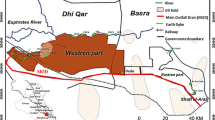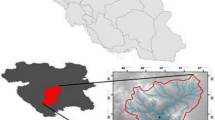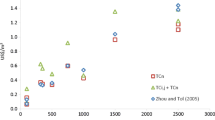Abstract
Due to the importance of reassessing water quality monitoring stations, we employed the performance of the dynamic programming approach (DPA) to locate the monitoring stations and their numbers at the Mond Basin Rivers, located in the south of Fars and Bushehr Province, Iran. Firstly, the present monitoring stations were classified and prioritized using the Strahler stream order system and geographic information system, and then, the objective function was developed in terms of irrigation and drinking purposes in the study area. The catchment area was broken into five subbasins, and each station separately was assigned a score between 10 and 90. The DPA showed a reduction in the existing stations from 16 to 12 for the irrigation concern and from 16 to 11 for drinking concern. The optimum number of stations in the study area was predicted to be 12 to satisfy the drinking and irrigation purposes together. The majority of retained stations were located in the southern part of the basin, which demonstrated that the river water quality conspicuously might be changed in comparison with the northern part. The compatibility between the DPA results, the ongoing catchment area situation and literature represented the suitability of DPA in optimizing the water quality monitoring stations and cutting redundant monitoring stations.



Similar content being viewed by others
References
Asadollahfardi, G. (2015). Water quality management, assessment and interpretation. Chapter 2, selection of water quality monitorig stations. Berlin: Springer.
Asadollahfardi, G., Asadi, M., & Nasrinasrabadi, M. (2014). Dynamic programming approach (DPA) for assessment of water quality network: A case study of the Sefid-Rud River. Water Practice and Technology, 9(2), 135–149.
Asgharpour, M. J. (2013). Multi-criteria decision making (11th ed.). Tehran: University of Tehran Press.
Cetinkaya, C. P., & Harmancioglu, N. B. (2012). Assessment of water quality sampling sites by a dynamic programming approach. Journal of Hydrologic Engineering, 17(2), 305–317.
Ghodrati, M. (2014). Applied learning of ArcGIS 10.2 with emphasis on water engineering and environmental issues (1st ed.). Tehran: Sima Danesh-Azar.
Harmancioglu, N. B., Fistikoglu, O., Ozkul, S. D., Singh, V. P., & Alpaslan, N. (1999). Water quality monitoring network design. Dordrecht: Kluwer.
Harmancioglu, N. B., Icaga, Y., & Gul, A. (2004). The use of an optimization method in the assessment of water quality sampling sites. European Water, 5(6), 25–35.
Icaga Y. (1998). Spatial optimization of hydrometric data networks by systems analysis techniques. Ph.D. Thesis, Graduate School of Natural and Applied Sciences, Dokuz Eylul University, Izmir, Turkey.
Icaga, Y. (2005). Genetic algorithm usage in water quality monitoring networks optimization in Gediz (Turkey) river basin. Environmental Monitoring and Assessment, 108(1–3), 261–277.
Karamouz, M., & Kerachian, R. (2015). Water quality planning and management (5th ed.). Tehran: Tehran’s Amir Kabir University Press (Tehran Polytechnic).
Letternmaier, D. P., Anderson, D. E., & Brenner, R. N. (1984). Consolidation of a stream quality monitoring network. Journal of the American Water Resources Association, 20(4), 473–481.
Ministry of Energy. (2013). Water and wastewater master plan studies department, updating of the master plan studies of Helle, Mond, Kal-Mehran, Sadij, and Southern Balochistan; Report No. 1: Environmental report of Mond basin, Tehran, Iran.
Rolimda Paz, A., Uvo, C., Bravo, J., Collischonn, W., & da Rocha, H. R. (2011). Seasonal precipitation forecast based on artificial neural networks. In H. do Prado, et al. (Eds.), Computational methods for agricultural research: Advances and applications (pp. 326–354). Hershey, PA: IGI Global.
Saaty, T. L. (1980). Analytical hierarchy process, planning, priority, resource allocation. Pittsburgh: RWS Publications.
Saaty, T. L., & Vargas, L. G. (1984). Inconsistency and rank preservation. Journal of Mathematical Psychology, 28(2), 205–214.
Sanders, T. G., Ward, R. C., Loftis, J. C., Steele, T. D., Adrain, D. D., & Yevjvich, V. (1983). Design of networks for monitoring water quality. Littleton, USA: Water Resources Publication.
Shamsaei, A., Oreei Zareh, S., & Sarang, A. (2005). The comparison of water indices and zoning quality in karoon and Dez rivers. Journal of Water and Wastewater, 16(55), 39–48.
Taghavi Moghadam, E. (2011). Geomorphological evolution of the northern Persian Gulf’s coast from Bushehr to Kangan. MSc Thesis, Department of Geographical Sciences, Kharazmi University, Tehran, Iran.
Author information
Authors and Affiliations
Corresponding author
Additional information
Publisher's Note
Springer Nature remains neutral with regard to jurisdictional claims in published maps and institutional affiliations.
Rights and permissions
About this article
Cite this article
Asadollahfardi, G., Heidarzadeh, N., Sekhavati, A. et al. Optimization of water quality monitoring stations using dynamic programming approach, a case study of the Mond Basin Rivers, Iran. Environ Dev Sustain 23, 2867–2881 (2021). https://doi.org/10.1007/s10668-020-00693-2
Received:
Accepted:
Published:
Issue Date:
DOI: https://doi.org/10.1007/s10668-020-00693-2




